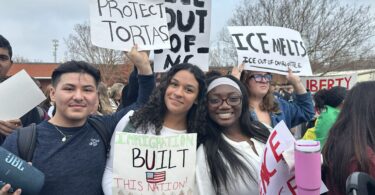Copenhagen, DENMARK – Adding an audio option to news stories opens a door for more people – especially those with disabilities – to access information, advocates said.
Listen to this story:
The Royal Society for Blind Children (RSBC) in the United Kingdom endorsed Youth Journalism International’s new initiative to add audio recordings – nearly always by the writer – for every article.
“RSBC welcomes the move from Youth Journalism International to include audio on all of its news stories. It’s incredibly important that blind and partially sighted young people can stay informed, and by providing audio, YJI will give them more independence through being able to control how and when they consume its content,” said RSBC.
Blind since the age of three, 38-year-old Hassan Khan has worked in the sight loss sector for over a decade.
Khan, who has his own podcast, supports the use of audio in journalism and said it can make information accessible where other formats fail.
“It’s absolutely crucial – the blind and partially sighted person wouldn’t have access to the information and therefore, you know, it’s not equal. There’s no equality. There’s no fairness,” said Khan. He is the Volunteer Services Manager at Merton Vision, a charity that has been supporting blind and partially sighted people in the London borough of Merton for 60 years.
In early March, Youth Journalism International began offering audio recordings of written articles to help make its reports more accessible.
“We want as many people as possible to connect with the work of Youth Journalism International students and we abhor any barriers that prevent it,” said Executive Director Jackie Majerus.
In most cases, the student who wrote the article makes the audio recording, although at times students have read each other’s work. The recordings are available with each article on the website but are also collected in a new Youth Journalism International channel on SoundCloud, www://soundcloud.com/youth-journalism.
“While some news organizations opt for an automated voice recording, we’re thrilled to be able to provide the real human voices of our wonderful students,” Majerus said.

Anthony Stephens, assistant vice president of communications at the American Blind Foundation, said the choice of a human voice matters.
For visually impaired people, Stephens said, listening to a synthetic voice is like reading a newspaper in a small type in the “impact bold” font.
But hearing a human voice creates a human connection and is especially good for older people, Stephens said.
Adding an audio option doesn’t just benefit people who are visually impaired, it also helps people with dyslexia.
“It opens the door to more inclusive journalism, helping not just those with dyslexia or vision impairments, but really anyone,” said Rosie Bissett, CEO of Dyslexia Ireland and President of the European Dyslexia Association.
People who don’t need the audio version may still enjoy or prefer to get the news by listening.
“It’s a perfect example of how designing for accessibility often ends up making things better for all of us,” said Bissett.
Noah Haynes is a Senior Reporter with Youth Journalism International from Denmark. He wrote this story.
Anjola Fashawe is a Senior Correspondent with Youth Journalism International from London. She contributed to this story.
Ann Tyshanok is a Junior Reporter and Senior Illustrator with Youth Journalism from Ukraine. She made the illustration.



